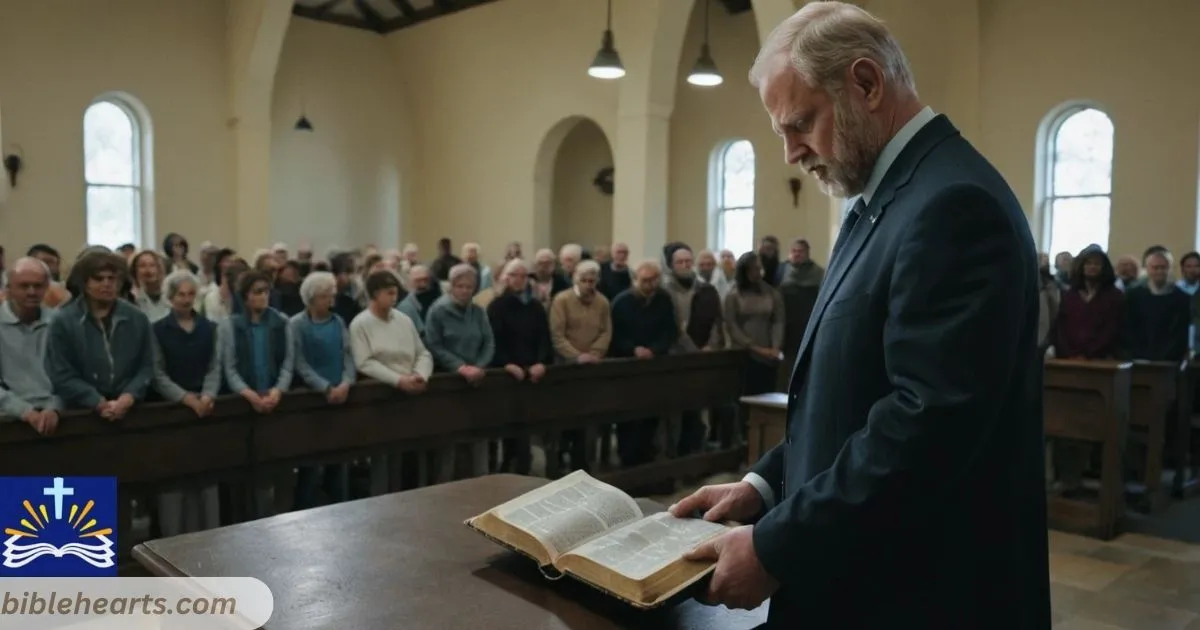“Standing during the reading of the Bible is a tradition deeply rooted in respect, reverence, and faith.“
Standing when Bible is read aloud has long been a practice observed in many religious communities. This gesture symbolizes respect and reverence for the sacred text. It serves as a reminder that the Word of God holds a central and authoritative role in the lives of believers. But is this practice just a tradition, or does it hold a deeper significance?
The practice of standing during Bible readings evokes various emotions and interpretations. For some, it is an act of honoring the divine authority of the scripture. For others, it’s a powerful way of engaging in communal worship. Understanding the origins and reasons behind this custom can help us appreciate its place in spiritual life.
In this blog post, we’ll explore whether standing during scripture reading is mandated in the Bible, why it’s considered respectful, its role in worship, and the differing perspectives on this tradition. By the end, you’ll have a comprehensive understanding of this age-old practice and its relevance today.
Is Standing While Reading the Bible in Scripture?
Biblical Basis
Standing for scripture has some foundation in the Bible. For example:
- Nehemiah 8:5-6: When Ezra opened the Book of the Law, the people stood up. This act was followed by their worship and praises to God.

- Luke 4:16-20: Jesus stood in the synagogue to read from the scroll of Isaiah, symbolizing respect for the Word of God.
While the Bible doesn’t explicitly command standing during scripture reading, these passages illustrate that standing was a practice used to show reverence in biblical times.
Example 1: Nehemiah’s Account
In the book of Nehemiah, the assembly stood as Ezra read the Word of God. This moment reflects their collective acknowledgment of scripture as holy and authoritative.
Example 2: Jesus in the Synagogue
When Jesus read from Isaiah, his standing demonstrated reverence for God’s Word and set a precedent for respectful engagement with scripture.
Why Do Modern Bible Translations Have Copyright?
Why is it Considered a Sign of Respect?
Cultural and Religious Symbolism
Standing is often associated with honor and respect in many cultures. Whether it’s standing for a national anthem, greeting a guest, or showing gratitude, this posture communicates deep reverence. In the context of scripture reading, standing is seen as a recognition of God’s supreme authority.
Example 1: Modern Ceremonies
Just as people stand for moments of silence during events, believers stand for scripture readings to symbolize solemnity and importance.
Example 2: Church Traditions
In denominations like Catholicism or Orthodox Christianity, standing during scripture readings forms a part of the liturgy, underscoring the importance of the moment.
The Significance of This Practice in Worship
Connecting with Faith
Standing during scripture reading helps believers physically and mentally align themselves with the worship. It signifies an active participation rather than passive listening.
Example 1: Engaged Worship
Churchgoers who stand while scripture is read are often more attentive, as the act draws their focus to the Word being spoken.
Example 2: Unity in Worship
When a congregation rises together, it symbolizes communal reverence and unity in honoring God’s Word
.Different Perspectives on Standing for Scripture Reading
Traditionalists vs. Modernists
- Traditionalists: They see standing as an irreplaceable act of honoring God, deeply embedded in faith traditions.
- Modernists: They argue that reverence can be shown in various ways, such as sitting attentively or engaging in quiet reflection.

Example 1: Protestant Practices
Many Protestant denominations leave it to individual choice, emphasizing personal connection with God rather than outward actions.
Example 2: Evangelical Services
In Evangelical churches, standing for scripture readings might depend on the church leader’s preference, with some emphasizing heart reverence over physical acts.
The Tradition of Standing During Bible Readings
- Nehemiah 8:5 – “Ezra opened the book. All the people could see him because he was standing above them; and as he opened it, the people all stood up.”
- 1 Timothy 4:13 – “Until I come, devote yourself to the public reading of Scripture, to preaching and to teaching.”
- Luke 4:16 – “He went to Nazareth, where he had been brought up, and on the Sabbath day he went into the synagogue, as was his custom. And he stood up to read.”
- Acts 13:15 – “After the reading from the Law and the Prophets, the leaders of the synagogue sent word to them, saying, ‘Brothers, if you have a word of exhortation for the people, please speak.’”
- Matthew 21:12 – “Jesus entered the temple courts and drove out all who were buying and selling there. He overturned the tables of the money changers and the benches of those selling doves.” (Referencing reverence in the temple)
- Revelation 1:10 – “On the Lord’s Day I was in the Spirit, and I heard behind me a loud voice like a trumpet, which said: ‘Write on a scroll what you see and send it to the seven churches.’” (Emphasizing reverence in hearing God’s word)
2Theological and Cultural Perspectives on Standing
- Romans 10:17 – “Consequently, faith comes from hearing the message, and the message is heard through the word about Christ.” (Acknowledging the importance of listening to God’s word with reverence)
- Philippians 2:10-11 – “That at the name of Jesus every knee should bow, in heaven and on earth and under the earth, and every tongue acknowledge that Jesus Christ is Lord, to the glory of God the Father.” (Indicating reverence and honor when hearing God’s word)
- Psalm 95:6 – “Come, let us bow down in worship, let us kneel before the Lord our Maker.” (Emphasizing humility and reverence during the reading of Scripture)
- 1 Corinthians 14:26 – “What then shall we say, brothers and sisters? When you come together, each of you has a hymn, or a word of instruction, a revelation, a tongue or an interpretation. Everything must be done so that the church may be built up.” (Exploring the cultural reverence in worship settings)
- Isaiah 66:2 – “Has not my hand made all these things, and so they came into being?’ declares the Lord. ‘These are the ones I look on with favor: those who are humble and contrite in spirit, and who tremble at my word.’” (Encouraging a reverent attitude toward God’s word)
- Hebrews 12:28-29 – “Therefore, since we are receiving a kingdom that cannot be shaken, let us be thankful, and so worship God acceptably with reverence and awe, for our ‘God is a consuming fire.’” (Suggesting the proper attitude of reverence and awe when in God’s presence)
Should We Always Stand When the Bible is Read?
The question of whether standing is necessary hinges on personal conviction and communal practice. While it’s a sign of respect, it’s not the only way to honor scripture. God values the heart’s attitude more than outward expressions.
- Answer: Standing is a meaningful practice, but it’s not mandated in scripture. Instead of focusing solely on the action, believers should prioritize their reverence for God’s Word in their hearts and minds.
Key Insight
1. Is it a sin not to stand when the Bible is read?
No, it’s not a sin. The Bible emphasizes the condition of the heart over outward actions.
2. What is the biblical basis for standing during scripture readings?
Examples like Nehemiah 8 and Luke 4 suggest that standing was a traditional sign of respect for the Word of God.
3. Do all churches require standing for scripture readings?
No, practices vary among denominations. Some encourage standing, while others focus on personal reverence.
4. Can sitting while scripture is read be respectful?
Yes, attentiveness, focus, and a reverent heart are also forms of respect for God’s Word.
5. How can I show reverence if I cannot stand?
You can bow your head, close your eyes in reflection, or listen attentively with a reverent heart.
Conclusion
Standing during the reading of the Bible is a powerful tradition that symbolizes respect and reverence for God’s Word. While not mandatory, it serves as a physical reminder of the scripture’s sacredness.
Whether one stands or remains seated, the most important factor is the attitude of the heart. What truly honors God is a sincere desire to engage with and apply His Word in daily life. By understanding and respecting these practices, believers can deepen their worship experience and foster a greater connection with their faith.

Hi! I’m Ethan Matthews, a tech enthusiast and avid traveler, sharing insights and adventures from my journeys around the globe.










